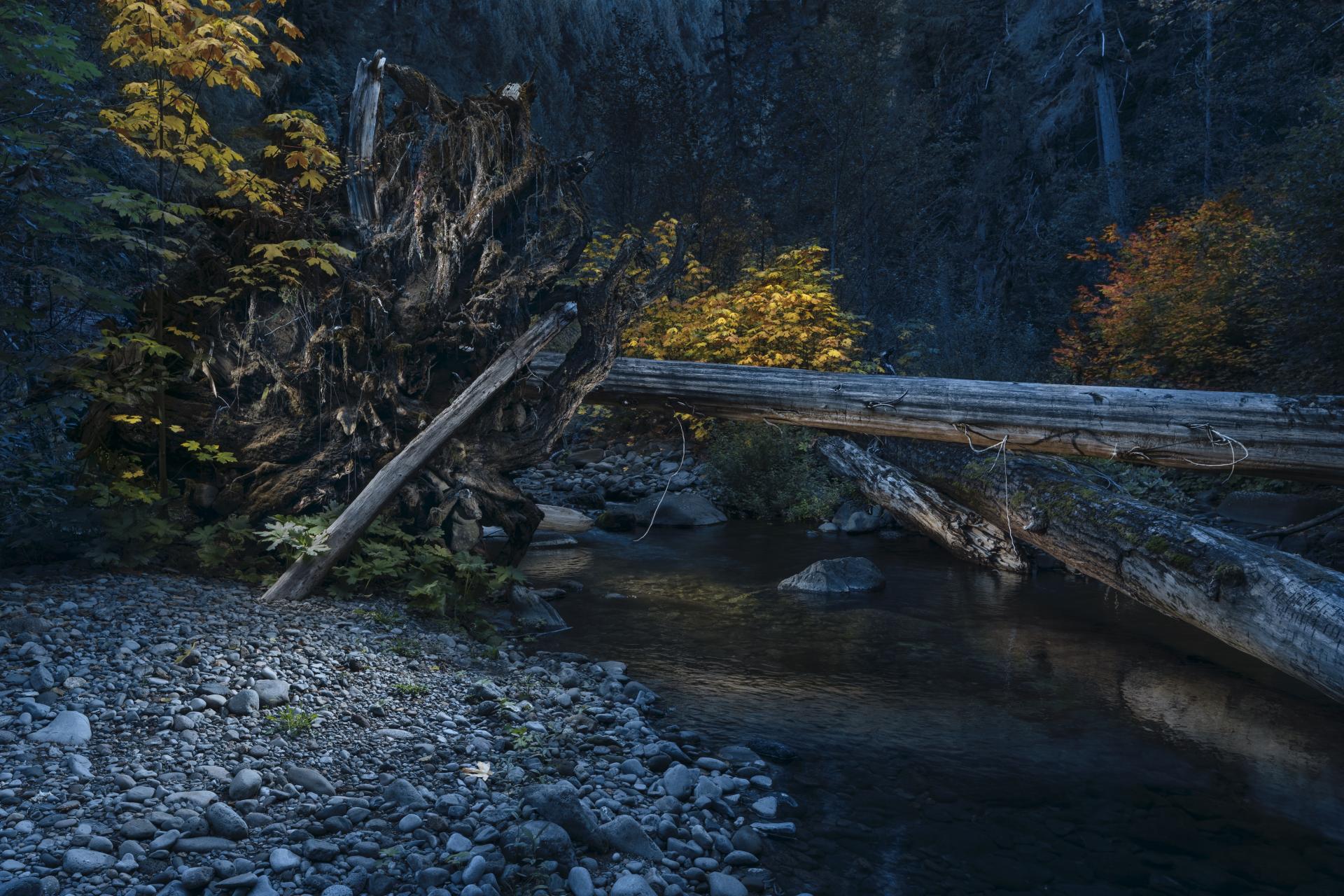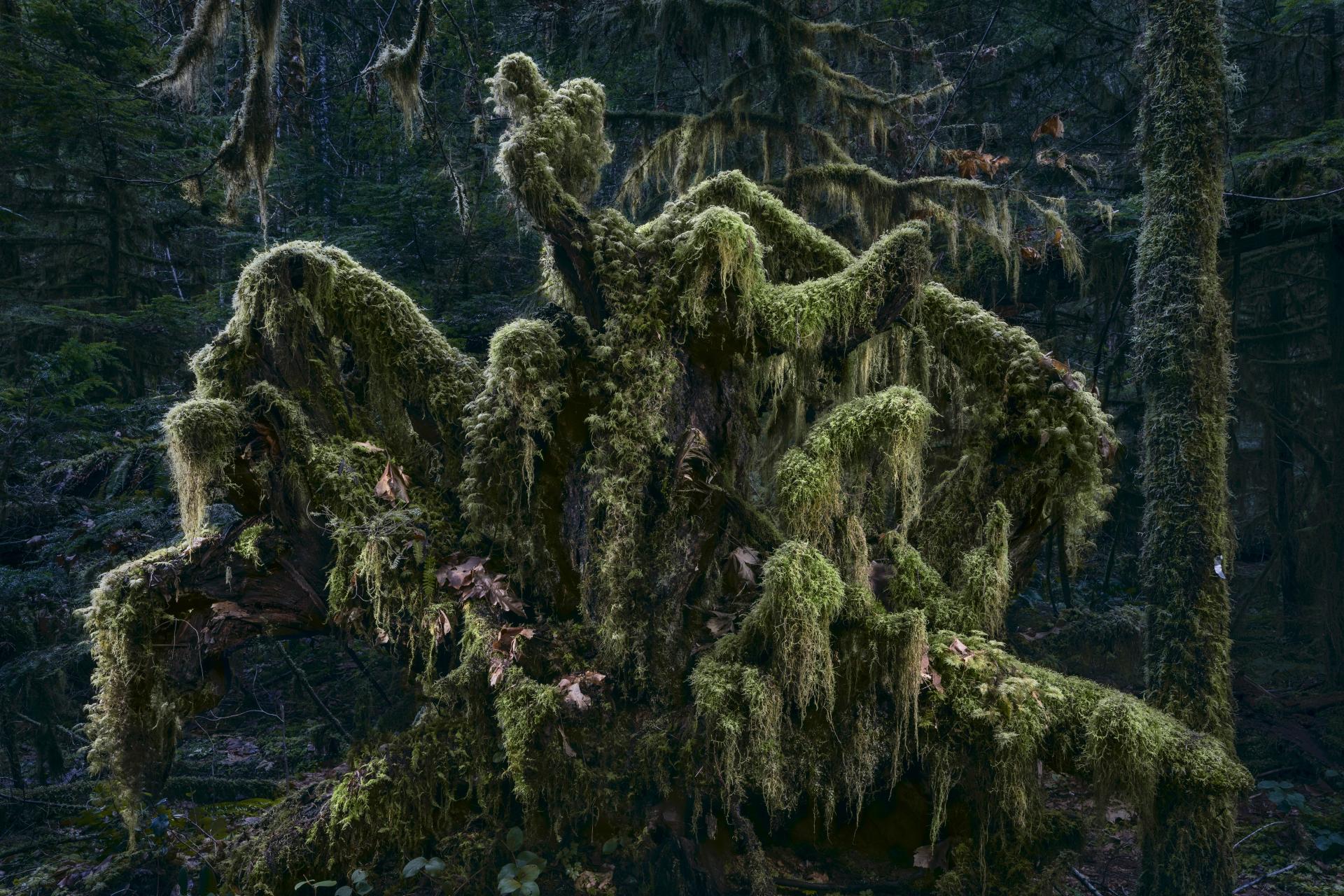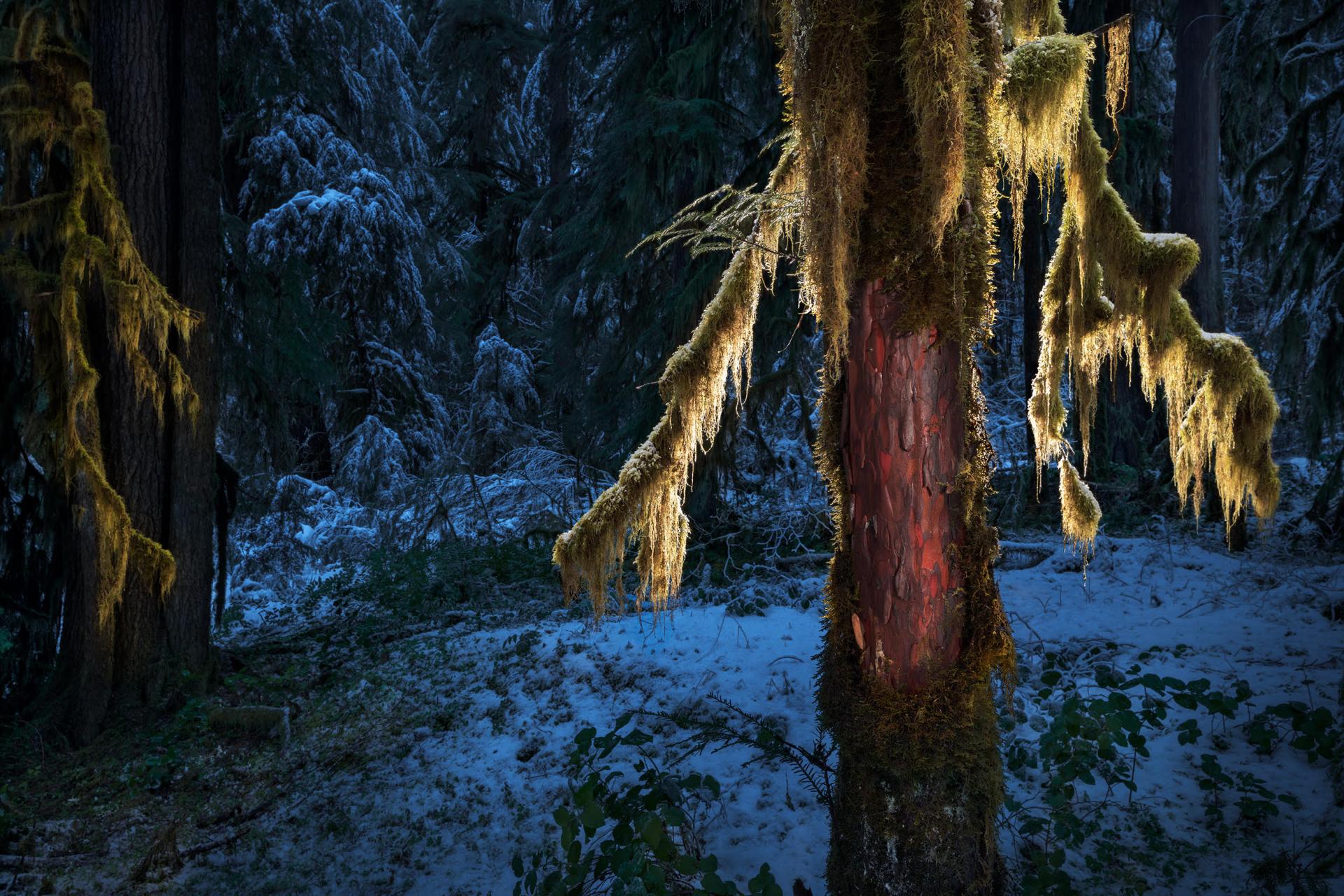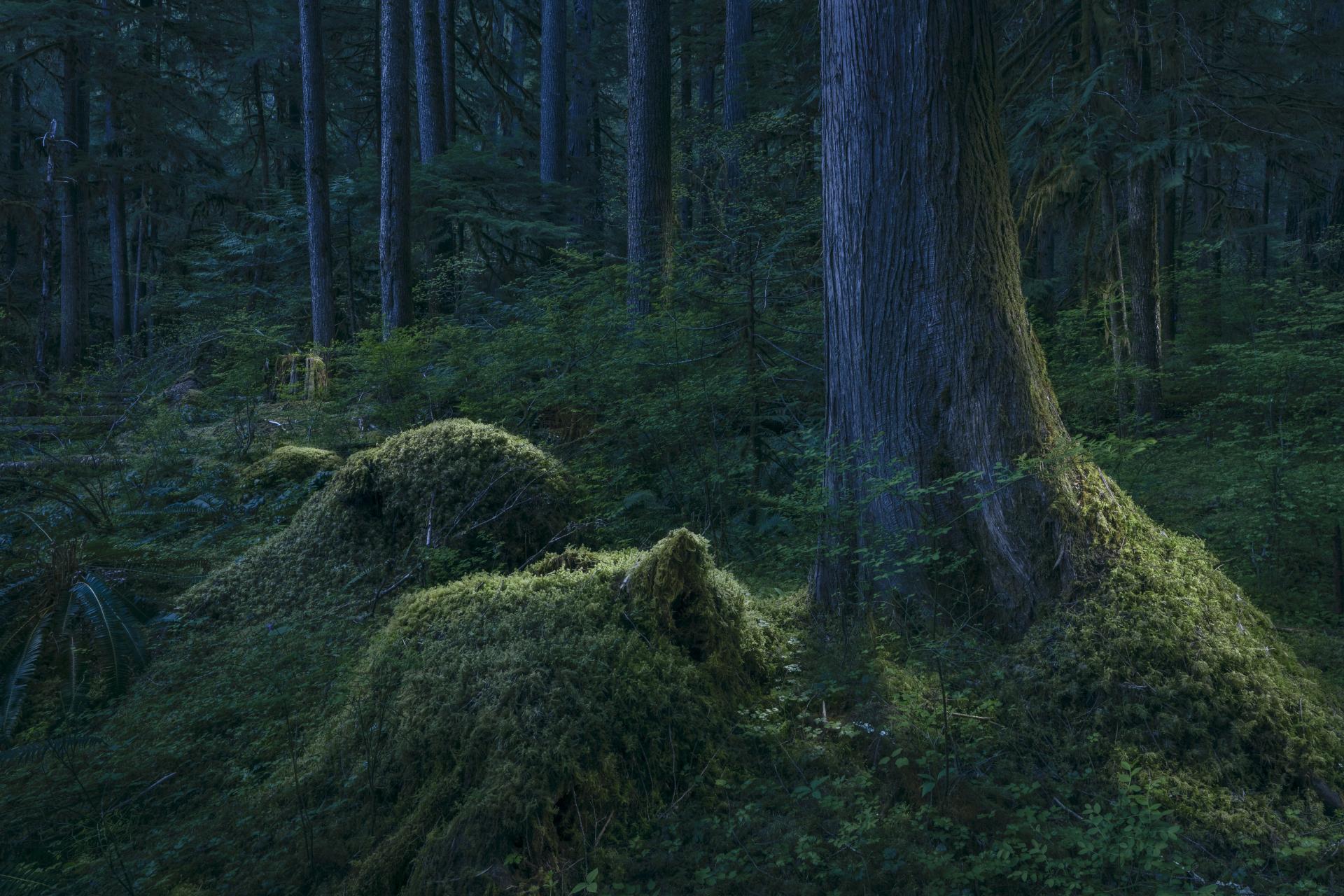Photographer David Paul Bayles focuses on landscapes where the needs of forests and human pursuits often collide, sometimes coexist, and on occasion find harmony. His connection with trees was forged in the mid-seventies when he worked for four years as a logger in the Sierra Nevada mountains. Last year, he was awarded an ongoing residency at the 16,000-acre H. J. Andrews Experimental Forest near Blue River, Oregon. These photographs of the forest are from his collection Old Growth Dialogue.
In Laudato si’, Pope Francis offers a vision of moral responsibility rooted in awareness of the world around us. He points to St. Francis, who “looked with love” on all creatures, as a model. He writes of an “attitude of the heart, one which approaches life with serene attentiveness, which is capable of being fully present” to everyone and everything. And he also calls for an “intense dialogue” between religion and science, which has its own “gaze.” The H. J. Andrews Experimental Forest in Oregon, one of the world’s most studied ecosystems, offers an especially rich opportunity for such dialogue. Here scientists have cultivated their own gaze of “serene attentiveness.” What can theology learn by looking with scientists at such a complex ecosystem?
Entering an old-growth forest can be overwhelming. The sheer, tangled abundance of life is shocking. If John Muir was right to describe these as “cathedrals,” they are messy and riotous ones. Massive trees, centuries old, rise from heaps of moss and ferns and disappear into the canopy above. Life overlaps everywhere, leaving no surface bare. Some trees are so covered with moss, lichen, or fungus that it’s difficult to see their bark or even needles. Curtains of damp moss hush sound. The scent of conifers and the earthy must of soil fill the air. Underfoot, the ground is soft and deep. There are so many layers, in every shade of green, that it is difficult to take it all in. There are hints at a timescale beyond human reckoning. Moss grows very slowly; yet here it covers just about everything. A tree bends toward an opening in the canopy that it filled centuries ago.

Encountering this riot of life can be like walking into a loud party full of many conversations (and more than a few fights), or arriving in the middle of the harmonies and dissonance of a complex symphony. It is tempting to focus on just one thing, to simplify. I reach out to touch an ancient Douglas fir, instinctively choosing a bare patch of bark stripped of moss. But the tree is far more than a single being. It hosts hundreds of plants and animals and depends on countless ecological interactions. Thinking like an individual, I miss the relationships. Ecology, like community, requires a gaze attentive to connection.
These were once called “decadent forests.” It’s easy to see why. The stunning vertical rise of firs, cedars, and hemlocks is coupled with so much falling and decay. Each day looks like the aftermath of a storm. Strips of lichen, moss, branches, and entire trees litter the floor. All this is being rotted by fungi and chewed by bugs. Fungus sprouts from enormous standing dead snags, revealing the rot within and impending collapse. What at first sight seems tumbling terrain—a hummock of ferns or even a small terrace—on closer look is revealed to be stumps or fallen trees decaying beneath blankets of moss. Life and death coincide, overlap, and interpenetrate.
For much of the twentieth century, forest managers’ explicit goal was to clear-cut decadent forests, burn the underbrush, and herbicide the soil. They would then plant orderly monoculture plantations of Douglas fir where trees would grow straight, fast, and healthy, freed from competition with undergrowth and safe from the infections harbored by diseased trees and rotting logs. Yes, they wanted timber, but they also wanted order: a simple order they could understand and control.
The Andrews is one of the places where scientists dared to gaze more attentively; and out of that emerged a revolution in understanding. Far from being “decadent,” these “old-growth” forests possess their own complex order as mature, biodiverse ecosystems. What appears as decay is essential to ecological flourishing.
That lichen cascading from the treetops—Lobaria oregana—turns out to be crucial. Nitrogen is a particular problem in a dense forest; the canopy closes after about a century, blocking the sun from nitrogen-fixing plants while trees are still young. Without this essential nutrient, they would fade long before reaching maturity. As the canopy closes, this lichen slowly establishes itself. Once established, it fills the gap, each year capturing tons of nitrogen per square mile that enters the soil as fallen strips decay on the forest floor.
Moss covering branches and trunks is often as old as the trees themselves. It plays an important role in capturing nutrients from the air and slowing the flow of rainfall down the tree so that nutrients remain near the trees’ roots. Rotting fungus, and bugs that consume dead trees, convert cellulose and lignin into soil nutrients that feed the astounding rise and near-millennial lifespan of these massive trees. Rot is itself life; there is more living tissue—bacteria, fungus, bugs—in a fallen tree than in a living one. Rising and falling, growth and rot, life and death are literally interconnected here.
None of this is obvious to a casual or even sincerely attentive observer. Much of it takes place outside the range of human sensation. Scientists struggle to broaden our scales of time and space in order to understand the hidden cycles of life. Learning the role of the lichen required chemical analysis and finding a way to work in the canopy, far above ground, to painstakingly measure the amount that grows on each branch. Knowledge of the cycle of log decay comes from an ongoing decomposition study that will follow the progress of fallen trees through the entire two hundred years it takes for a log to become soil. Gas emissions and fluid runoff are measured and analyzed. Bacteria, fungi, and bugs are microscopically cataloged, and their progress through tree tissue is carefully measured. This devotion and commitment from multiple generations of scientists certainly justifies considering the scientific a form of “serene attentiveness.”
This work attending to the fullness of creation has revealed astounding complexity. As we walk through the forest, we notice plants and animals around us, but often we literally miss the forest’s interconnections for the trees. The greatest part of its biodiversity lies below ground, where thousands upon thousands of species of worms, arthropods, and insects live, each hosting a different bacterial community in its gut. We used to think of soil as a test tube full of chemicals, but now know that it’s a complex biological network; we are only beginning to understand its thousands of parts. These are “trophic” networks: who eats what and whom. The complexity goes far beyond predator and prey. Everything from a fallen evergreen needle to a tree is consumed, and the droppings of the consumers are consumed by yet other species through cycles upon cycles.
Below ground lives another complex web that facilitates one of the most astounding sets of relationships in the forest: mycorrhizal fungi. Unlike saprophytic fungi which live on decaying matter, mycorrhizal fungi live in symbiosis with living plants. Scientists have known these soil fungi are important for more than a century. Only in the past few decades, however, have they found ways to study the complexity of these relationships in detail. Electron microscopes show that mycorrhizal fungi filaments surround and penetrate plants’ root hairs. On the most basic level, trees share sugars with the fungus; the fungus extends their root systems’ reach a thousand-fold into microscopic nooks and crannies. The underground portion of fungi is much larger than the mushrooms we see. DNA analysis reveals that they can extend for hundreds of yards or even miles, linking the root systems of many trees, including different species, into a network that shares nutrients, water, chemical alerts, and even electrical signals. Using carbon-14 isotopes, Susan Simard famously found evidence of Douglas firs sharing sugar with birches in the spring and fall, and receiving sugar back when they leafed out in the summer. Older trees not only nurse their young through these networks; they serve as anchor points of complex networks that link entire stands of trees. One study found as many as sixty-five separate fungus species forming root networks in Douglas fir forests.
This research is breathtaking. Far from a ruthless competition of individuals for water and nutrients, we find diverse communities supporting their members. Vast, complex, multi-species networks thrive by sharing resources and information. The vocabulary used is as consonant with Catholic social thought as the reality it describes. The technical term used for these multispecies networks is “cooperative guilds.” There is a common good in the forest.

We learn three connected lessons in an old-growth forest: creation is profoundly interrelated; interrelatedness is not simply a truth about ecology that we observe, but a truth about ourselves in which we participate; and an ethos of attentiveness can bring the limits of our knowledge into our moral imagination.
The first lesson of the forest is scientific confirmation of the key theme of Laudato si’—“everything is interconnected.” These few remaining intact ecosystems serve as sacraments of the Holocene. In them, we can find a kind of anamnesis of the living complexity of the world in which we evolved, and develop an appreciation for the gift that birthed us. This is not to gloss over the hard truths of evolution by forcing ecology to narrate a secular Eden. Predation and parasitism are as prevalent as symbiosis and mutualism. The density of relationship is, however, unmistakable.
No individual plant or animal, and indeed no species, is an island. Ecological niches aren’t really patches of ground defended from competitors, but multidimensional relationships. Remove one part and the rest can falter. For thousands of years, humans have been cutting down the great temperate and tropical forests that once covered much of the earth, resulting not just in the loss of trees, but in the destruction of massive, complex ecosystems.
The effects of deforestation can take years, decades, and even centuries to appear. On ecological timescales, the agriculture we replace them with often proves frightfully short-lived. In so many places, deserts now spread where forests once flourished. The narrow scope of what we value has remade the world. That impoverishment unfolds today in what scientists are calling the sixth mass-extinction event—human activity is eliminating species on a scale that ranks with the previous catastrophic die-offs that punctuate the geological record. We will bequeath this impoverishment to our own children, and to the rest of the species forced to live on the planet we understood too little to share.
We don’t simply learn about the world around us, however, when we study these forests; we also learn the truth that we ourselves are part of a creation that reflects the relational character of the triune God. For this reason, Laudato si’ connects ecological attentiveness to a Trinitarian spirituality:
The divine Persons are subsistent relations, and the world, created according to the divine model, is a web of relationships. This leads us not only to marvel at the manifold connections existing among creatures, but also to discover a key to our own fulfilment.
The beauty of the forest bears the truth of ecological interconnection. This turns out to be a moral truth as well.
The human person grows more, matures more and is sanctified more to the extent that he or she enters into relationships, going out from themselves to live in communion with God, with others and with all creatures. In this way, they make their own that trinitarian dynamism that God imprinted in them when they were created. Everything is interconnected, and this invites us to develop a spirituality of that global solidarity that flows from the mystery of the Trinity.
We are created amidst communion, for communion with God along with the rest of creation.

Forests and the scientists who study them do more than confirm our religious beliefs about communion. They also challenge us to recognize the ways our individualism runs even deeper than we realize, untouched by our professions of faith. We really prefer to ignore the interconnection between decay and life and what this tells us about our connections with others. While we may thrill at the networked community facilitated by the hyphae of “good” mycorrhizal fungi, we shudder at the penetrating tendrils of the fungi of rot. Yet the towering bodies of giant trees are composed of the bodies of countless dead, decayed ancestral generations. As are we.
“Remember you are dust, and to dust you shall return.” The Ash Wednesday admonition is a reference to Genesis in which God fashions Adam from “dust” or “clay.” We generally read this as an expression of our nothingness without God’s animating Spirit. Yet some Scripture scholars argue the Hebrew here can and should be rendered soil. Indeed, Adam’s very name is a play on the Hebrew word for soil. As the whole arc of the Eden story presumes, God creates and places us within a system of relationships. Our refusal harms them all: “Cursed is the soil because of you.” What if we prayed the more biblically accurate: “Remember you are soil, and to soil you shall return”? Our bodies are not our own, separate from relationships human and natural, but part of cycles that require we give back what we take, even our flesh. “Take…this is my body” resonates in places we seldom imagine. Our refusal is institutionalized in our modern death ritual of shutting “our” bodies off from the rest of creation in metal and concrete boxes, where indeed, rather than return to the soil, they decay to dust.
The final lesson is perhaps the most challenging. Here we learn how very difficult it is to be attentive. On a moral level, we must struggle with the objectifying gaze of what Francis calls the “technocratic paradigm,” that sees the rest of creation as a “mere object subjugated to arbitrary human domination.” The Synod of the Amazon’s proposed definition of “ecological sin” focuses precisely on ignoring and transgressing the “interdependence...and networks of solidarity among creatures.” From the very few remaining fragments of old-growth forests, one need not look far to find clear-cuts and monoculture tree plantations which manifest the devastation that such a sinful view of creation produces.
But our moral blindness arises from our finitude as much as our sin. Creation is an astoundingly complex web of relationships. Most of these are not easily perceived by the ordinary range of human perception. To play on but one of our limited senses, if the forest is a symphony, its harmonies and dissonances include notes far higher and lower than we can easily imagine, let alone hear: from the atomic vibrations of photosynthesis to bass notes sounding in the millennial rise and fall of trees. Scientists turn to chemistry, DNA analysis, and electron microscopes to study dimensions of the life of the forest far beyond the range of our natural perception. The difficulties of this scientific work alert us to just how much we miss.
The interplay of knowledge, imagination, and grace lets us encounter the astounding complexity of forests more fully. Out of this interplay comes moments when awareness flickers; each plant, rock, and decaying leaf reverberates in its manifold interconnections. Green deepens into the viriditas that Hildegard von Bingen named the Spirit’s work in creation and we catch a glimmer of the harmony that surrounds us. Full comprehension escapes us, as both complexity and grace are beyond our ken. But the more knowledge we have of particulars, the more our understanding of complexity grows; and with this, awareness of evermore dimensions that we do not comprehend.
We need to incorporate such awareness of our limited perception into our everyday moral imagination. We act powerfully in the world, seldom knowing the full consequences of our actions. We have been doing so for millennia. The disappearance of large animals from ecosystems has been the hallmark of human activity since the Pleistocene. Humans are the great disrupters: hunting animals too large for any animal predator and reworking entire landscapes with agriculture. Such ignorance is fundamental to the global market system, which works precisely by reducing the complexities of the ecological, social, and cultural costs of production to a price signal.
Our disruptions have now reached the planetary scale. Our future, and the future of the countless species along for the ride with us, depends upon our cultivating a sense of our ignorance and a corresponding hesitance to act in haste. Will we keep our eyes closed in indifference or open them to the astounding complexity of creation and learn anew how to respond in love?

Please email comments to [email protected] and join the conversation on our Facebook page.
Previous Story
A Harmful Doctrine
Next Story
Books in Brief

